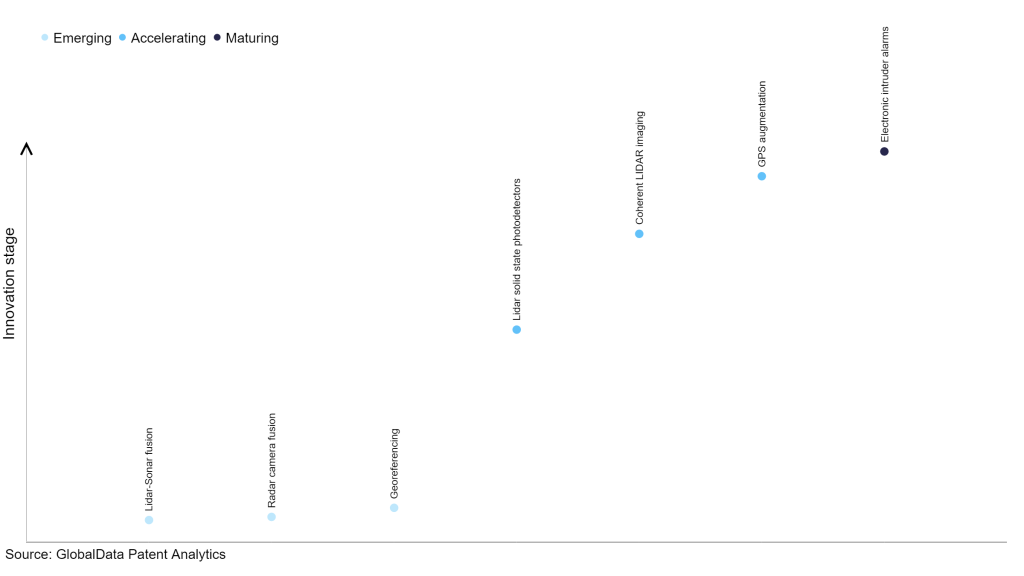The aerospace and defense industry continues to be a hotbed of patent innovation. Activity is driven by the pressing need for modernization and the growing importance of emerging technologies such as artificial intelligence and unmanned systems. In the last three years alone, there have been over 84,000 patents filed and granted in the aerospace and defense industry, according to GlobalData’s report on Internet of Things in defense: LiDAR-sonar fusion. Buy the report here.
However, not all innovations are equal and nor do they follow a constant upward trend. Instead, their evolution takes the form of an S-shaped curve that reflects their typical lifecycle from early emergence to accelerating adoption, before finally stabilizing and reaching maturity.
Identifying where a particular innovation is on this journey, especially those that are in the emerging and accelerating stages, is essential for understanding their current level of adoption and the likely future trajectory and impact they will have.
110 innovations will shape the aerospace and defense industry
According to GlobalData’s Technology Foresights, which plots the S-curve for the aerospace and defense industry using innovation intensity models built on over 260,000 patents, there are 110 innovation areas that will shape the future of the industry.
Within the emerging innovation stage, LiDAR-Sonar fusion, radar camera fusion, and georeferencing are disruptive technologies that are in the early stages of application and should be tracked closely. LiDAR solid state photodetectors, coherent LiDAR imaging, and GPS augmentation are some of the accelerating innovation areas, where adoption has been steadily increasing. Among maturing innovation areas is electronic intruder alarms, which is now well established in the industry.
Innovation S-curve for Internet of Things in the aerospace and defense industry

LiDAR-sonar fusion is a key innovation area in Internet of Things
Both LiDAR and Sonar collect and analyse data about the surrounding environment. LiDAR does this by collecting information through lasers whereas Sonar does this through the emission of sound waves. LiDAR and Sonar data can be fused in order to provide a more detailed picture about the surrounding environment.
GlobalData’s analysis also uncovers the companies at the forefront of each innovation area and assesses the potential reach and impact of their patenting activity across different applications and geographies. According to GlobalData, there are 160 companies, spanning technology vendors, established aerospace and defense companies, and up-and-coming start-ups engaged in the development and application of LiDAR-sonar fusion.
Key players in LiDAR-sonar fusion – a disruptive innovation in the aerospace and defense industry
‘Application diversity’ measures the number of applications identified for each patent. It broadly splits companies into either ‘niche’ or ‘diversified’ innovators.
‘Geographic reach’ refers to the number of countries each patent is registered in. It reflects the breadth of geographic application intended, ranging from ‘global’ to ‘local’.
Patent volumes related to LiDAR-Sonar fusion
Source: GlobalData Patent Analytics
Robert Bosch Stiftung is the leading patent filer in LiDAR-Sonar fusion. Robert Bosch is a Germany-based non-profit organization, which funds research programs. It has been listed as an assignee on various patents related to LiDAR-Sonar Fusion, including those that relate to improved object identification. Some other key patent filers include Porsche Automobil, Amazon.com, and Valeo.
In terms of application diversity, Robert Bosch Stiftung leads the pack. Amazon.com and State Farm Mutual Automobile Insurance stand in the second and third positions, respectively. By means of geographic reach, State Farm Mutual Automobile Insurance holds the top position, followed by 3D at Depth, SoftBank Group, DEKA Research and Development, and Seoul Robotics.
LiDAR-sonar fusion has a sizeable number of patents filed by companies with a primarily commercial market focus. Major defense companies to have filed patents in this field are Boeing and BAE Systems. Patents filed by defense companies include those that relate to threat identification and tracking systems.
To further understand the key themes and technologies disrupting the aerospace and defense industry, access GlobalData’s latest thematic research report on Aerospace & Defense.
Data Insights
From

The gold standard of business intelligence.
Blending expert knowledge with cutting-edge technology, GlobalData’s unrivalled proprietary data will enable you to decode what’s happening in your market. You can make better informed decisions and gain a future-proof advantage over your competitors.



